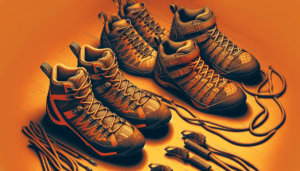Table of Contents
ToggleIntroduction to Trad Climbing
What is Trad Climbing?
If you’re new to the world of rock climbing, you may have come across the term “trad climbing.” Traditional climbing, or trad climbing, is a style of rock climbing where the climber places their own gear for protection rather than relying on pre-installed bolts or anchors (GearJunkie). This means that instead of clipping into fixed bolts, trad climbers insert removable gear such as nuts, cams, hexes, and slings into cracks and other features of the rock to secure the rope and protect against falls.
Trad climbing provides a unique and challenging experience, as it requires climbers to carefully evaluate the rock and choose the appropriate gear for each placement. It demands a combination of technical skill, route-finding ability, and a keen sense of judgment. Many climbers find the self-reliance and problem-solving aspect of trad climbing to be incredibly rewarding.
The Importance of Trad Climbing Protection
In trad climbing, protection refers to the gear and equipment used to protect a climber in the event of a fall or slip (Climbing.com). The primary purpose of protection is to minimize the consequences of a fall by arresting the climber’s downward movement and preventing them from hitting the ground or ledges.
Trad climbing protection plays a crucial role in ensuring climbers’ safety and minimizing the risk of injury. By placing reliable and secure gear, such as nuts, cams, hexes, and slings, climbers can create anchor points that can withstand the forces generated during a fall. The gear acts as a lifeline, transferring the energy of the fall to the rock and the rope, reducing the impact on the climber’s body.
Understanding the different types of trad climbing protection and how to properly place them is essential for a safe and enjoyable climbing experience. It allows climbers to confidently navigate routes, knowing they have taken the necessary precautions to protect themselves in case of a fall.
In the next section, we will explore the various types of trad climbing protection, including nuts, cams, hexes, and slings. By understanding the characteristics and uses of each type, you’ll be better equipped to select the right gear for your trad climbing adventures.
Types of Trad Climbing Protection
When it comes to trad climbing, having the right gear is essential for safety and success. Trad climbing protection refers to the equipment used to secure oneself to the rock face, providing anchors and preventing falls. There are several types of trad climbing protection available, each with its own unique characteristics and applications. Let’s explore the different options:
Nuts: Versatile and Reliable
Nuts, also known as chocks or wired stoppers, are passive pieces of trad climbing protection that are inserted into narrow cracks or constrictions in the rock. They consist of metal wedges with attached wires that can be placed into the crack, relying on the friction between the rock and the wire to hold them in place. Nuts are known for their versatility and reliability, making them a popular choice among trad climbers. They come in various sizes to accommodate different crack widths. For more information on nuts and their usage, check out our article on trad climbing nuts.
Cams: Expandable and Secure
Cams, also known as camming devices or friends, are active pieces of trad climbing protection that have expandable lobes. These devices can be placed into cracks and then expanded to create friction and hold them in place. Cams are highly adjustable, allowing climbers to find the perfect fit for the crack they are placing them in. This versatility and secure placement make cams a popular choice for many trad climbers. To learn more about cams and their usage, visit our article on trad climbing cams.
Hexes: Versatile Anchors
Hexes, also known as chocks or hexcentrics, are another type of trad climbing protection. These hexagonal-shaped pieces of gear are inserted into cracks to provide anchor points for the climber. Hexes are versatile because each side of the hex can be used in different crack sizes, allowing climbers to adapt to a variety of situations. They are often used in conjunction with other types of protection to create a secure anchor system. To explore more about hexes and their usage, refer to our article on trad climbing hexes.
Slings: Extending Reach and Reducing Rope Drag
Slings, also known as runners, are essential components of a trad climber’s gear. These nylon or Dyneema loops are used to extend the reach of protection placements, reducing rope drag and allowing for more efficient climbing. Slings can also be used to create natural anchors by wrapping them around features like trees or rock horns. They are available in various lengths to accommodate different climbing scenarios. For more information on slings and their applications, check out our article on trad climbing slings.
Understanding the different types of trad climbing protection is crucial for choosing the right gear for your climbing adventures. Nuts, cams, hexes, and slings each have their own advantages and considerations, so it’s important to familiarize yourself with their usage and techniques. By having a well-rounded selection of trad climbing protection in your gear arsenal, you’ll be better equipped to navigate the challenges of trad climbing and enjoy the thrill of the vertical world.
Placing Trad Climbing Protection
To ensure a safe and enjoyable trad climbing experience, it’s essential to master the art of placing trad climbing protection. Properly evaluating rock features, selecting the right gear, and employing effective placement techniques are crucial steps in maintaining security on the wall.
Evaluating Rock Features
Before placing any trad climbing protection, it’s important to thoroughly evaluate the rock features. Look for cracks, fissures, and other natural features that can accommodate different types of gear. Consider the size and shape of the crack or feature to determine the most suitable protection option. Remember that rock quality varies, so always assess the stability and integrity of the rock before placing any gear. This evaluation process will help you determine the type and size of protection needed for each section of the climb.
Selecting the Right Gear
Trad climbing protection comes in various forms, each with its own advantages and applications. The most common types of trad climbing protection include nuts, cams, hexes, and slings. Nuts, also known as nuts or stoppers, are versatile pieces of gear that can be wedged into cracks to provide secure anchor points (Climbing.com). Cams, on the other hand, expand to fit different crack sizes and offer reliable anchoring options (Climbing.com). Hexes, also known as chocks or hexcentrics, can be inserted into cracks to provide stable anchor points (Climbing.com). Slings play a vital role in extending reach and reducing rope drag, allowing for more efficient protection placements.
When selecting the right gear, consider the size and shape of the crack or feature you are aiming to protect. Ensure that your gear fits securely and snugly within the rock. It’s also important to have a variety of sizes and types of protection in your rack to accommodate different crack sizes and shapes. For a comprehensive guide on trad climbing gear, explore our article on trad climbing gear.
Proper Placement Techniques
Placing trad climbing protection requires skill and precision. Start by identifying a suitable crack or feature where you want to secure your protection. Clean any loose debris or dirt from the crack to ensure a solid placement. Insert the chosen protection into the crack, making sure it sits snugly and securely. Give it a gentle tug to test its stability. If it wiggles or feels loose, try adjusting its placement or selecting a different size of gear.
It’s important to avoid overcamming or overstuffing the crack with gear, as this can compromise the integrity of the placements. Additionally, be mindful of avoiding placements behind loose flakes or hollow-sounding rock, as they may not provide reliable anchoring points. Practice proper techniques for setting nuts, cams, hexes, and slings to ensure secure and effective placements.
For beginners, seeking guidance from experienced trad climbers or taking a trad climbing course can provide invaluable insights and hands-on experience in learning how to place trad climbing protection effectively and safely.
Remember, the proper evaluation of rock features, careful selection of gear, and mastering proper placement techniques are fundamental to ensuring a secure and successful trad climbing experience. Prioritize safety and always double-check your placements before committing to them. For more tips and techniques on trad climbing, check out our article on trad climbing techniques.
Importance of Trad Climbing Protection
When engaging in trad climbing, the significance of proper protection cannot be overstated. Protection is the cornerstone of the climbing system, alongside a rope, as it plays a crucial role in preventing dangerous falls and minimizing the risk of accidents and injuries. As I strive to be a skillful and prudent climber, ensuring the appropriate use of trad climbing protection is of utmost importance.
Preventing Dangerous Falls
Protection in trad climbing is designed to catch a falling climber, preventing them from hitting the ground or sustaining severe injuries. Adequate and strategically placed protection acts as a safety net, arresting falls and allowing climbers to continue their ascent with confidence. It provides reassurance and peace of mind, particularly when facing challenging sections of a route.
Avoiding Accidents and Injuries
Failures in a lead climber’s protection system, such as protection pulling out or using inadequate protection, have been identified as common causes of climbing accidents (American Alpine Club). Accurate assessment and placement of protection are vital to ensure its effectiveness and reliability. By diligently adhering to best practices, including evaluating rock features, selecting appropriate gear, and employing proper placement techniques, climbers can significantly reduce the likelihood of accidents and injuries.
Skillful and Prudent Climbing
The lead climber’s protection system, or lack thereof, is a significant factor in skillful and prudent climbing. It requires a thorough understanding of the climbing environment, rock quality, equipment capabilities, and personal limitations. By employing sound judgment and employing trad climbing protection techniques effectively, climbers can navigate routes with heightened control and safety, allowing them to enjoy the experience to its fullest.
In conclusion, trad climbing protection is not just a mere accessory; it is a critical component that ensures the safety and well-being of climbers. By recognizing the importance of preventing dangerous falls, avoiding accidents and injuries, and cultivating skillful and prudent climbing practices, I can embark on trad climbing adventures with confidence and peace of mind.
Common Mistakes to Avoid in Trad Climbing Protection
In the world of trad climbing, proper placement and evaluation of protection is crucial to ensure its effectiveness and reliability. Making mistakes in protection placement can have serious consequences. Let’s explore two common mistakes to avoid in trad climbing protection.
Inadequate or Improper Protection Placement
One of the most critical mistakes climbers can make is placing inadequate or improper protection. In 2012, there were 11 reported incidents where the immediate cause of an accident was protection pulling out, and inadequate or improper placement was often a contributing factor (American Alpine Club). To avoid this mistake, climbers must carefully assess the rock features and select the appropriate gear for each placement.
When placing protection, it’s important to evaluate the strength and stability of the rock. Look for solid cracks, pockets, or other features that can securely hold the gear. Avoid relying on loose or suspect rock for placements. Additionally, consider the direction and magnitude of potential forces that may be applied to the gear during a fall. Placing protection in the right locations and with proper orientation can significantly enhance its strength and reliability.
To minimize the risk of inadequate or improper protection placement, climbers should receive proper training and guidance from experienced climbers or certified instructors. Learning from experienced mentors and practicing on different types of rock formations can help develop the necessary skills and judgment to make sound protection placement decisions.
Failure to Evaluate and Assess Rock Quality
Failure to evaluate and assess rock quality is another common mistake in trad climbing protection. In 2012, inadequate or improper protection placement, including failure to evaluate and assess rock quality, contributed to 27 accidents (American Alpine Club). Similar numbers of accidents caused by failures in the lead climber’s protection system were reported in 2013 (American Alpine Club).
Before placing protection, climbers should carefully inspect the rock for any signs of weakness, loose flakes, or fractured sections. Tap the rock gently to listen for hollow sounds or vibrations, which may indicate potential instability. It’s crucial to have a solid understanding of the rock type and its inherent characteristics, as different types of rock may require different protection techniques or gear.
Regularly updating knowledge of rock quality and seeking updated information about climbing routes from guidebooks, fellow climbers, or online resources can help climbers make informed decisions when evaluating and assessing rock quality. Additionally, climbers should stay up to date with best practices and advancements in trad climbing protection techniques to ensure they are well-prepared for various rock conditions.
By avoiding these common mistakes and focusing on proper protection placement and rock quality evaluation, climbers can enhance their safety, reduce the risk of accidents, and enjoy a more rewarding trad climbing experience. Remember, trad climbing is an adventure that requires attention to detail, skill, and ongoing learning to ensure a safe and enjoyable climb.
Placing Trad Climbing Protection
When it comes to trad climbing, the proper placement of protection is essential for safety and to prevent accidents. Trad climbing protection requires careful evaluation of the rock features and the selection of appropriate gear for each section of the climb (Climbing.com). By understanding the importance of proper placement techniques, climbers can enhance their safety and increase their confidence on the wall.
Evaluating Rock Features
Before placing trad climbing protection, it’s crucial to evaluate the rock features to identify suitable placements. Look for cracks, pockets, or other features that can accommodate various types of protection. Assess the quality and stability of the rock, considering factors such as loose holds or potential rockfall. By carefully evaluating the rock features, you can make informed decisions about the most appropriate gear and placement techniques to use.
Selecting the Right Gear
Choosing the right gear is paramount in trad climbing protection. Different types of protection, such as nuts, cams, hexes, and slings, offer varying advantages in different rock types and crack sizes. Understanding the characteristics and limitations of each type of gear is essential for effective placement. For more information on the types of trad climbing protection and their features, refer to our article on trad climbing gear.
Proper Placement Techniques
Proper placement techniques ensure the effectiveness and reliability of trad climbing protection. Here are some key guidelines to follow:
-
Clean the placement: Remove any loose rocks, debris, or dirt from the crack or feature before placing your protection. This helps ensure a solid and secure placement.
-
Inspect the gear: Before placing the gear, carefully examine it for any signs of wear or damage. Check the strength and functionality of cams, nuts, or hexes, and ensure that slings are free from cuts or fraying.
-
Aim for solid placements: Look for placements that offer solid contact with the rock, minimizing the risk of shifting or dislodging. Seek out cracks that taper inward rather than flaring outward, as these tend to provide more secure placements.
-
Test the placement: After inserting the gear, give it a gentle tug or bounce to assess its stability. Listen for any unusual sounds or movement that could indicate an insecure placement.
-
Consider redundancy: Whenever possible, use multiple pieces of protection to create redundancy. This means placing additional gear nearby to provide backup in case one piece fails.
For more detailed information on trad climbing protection techniques, consult our article on trad climbing techniques.
By following these guidelines and practicing proper placement techniques, climbers can enhance their safety and confidence while trad climbing. Remember that the importance of trad climbing protection cannot be overstated, as it helps prevent dangerous falls and avoid accidents and injuries (American Alpine Club). Always prioritize safety and take the time to learn and master the art of placing trad climbing protection.










